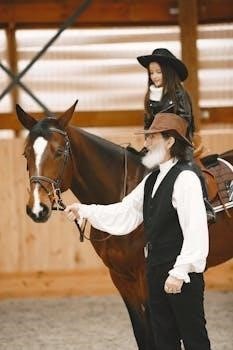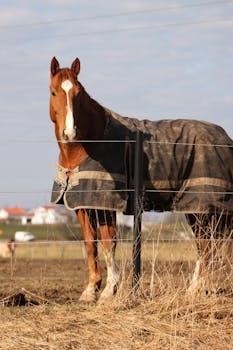Types of Horse Blankets and Sheets
Horses require different types and weights of blankets based on temperature and conditions․ Horse sheets are lightweight with little fill, while blankets have filling for extra warmth․ Selecting the right type is crucial․
Sheet vs․ Blanket
The primary distinction between a horse sheet and a horse blanket lies in their construction and intended purpose․ A horse sheet is typically a lightweight covering, often made from materials like nylon or cotton, and it offers minimal insulation, serving primarily as a barrier against wind, dust, and insects․ In contrast, a horse blanket is designed to provide warmth․ It incorporates a filling, such as fiberfill or down, to trap body heat․ Blankets come in varying weights and thicknesses, making them suitable for different temperatures and levels of cold protection․ Therefore, sheets are for light protection, while blankets are for warmth․

Horse Fleece Material
Horse fleece is a synthetic material similar to wool, valued for its warmth and light weight․ It offers benefits like moisture control, good skin health, and secure fit, making it suitable for year-round use․
Types of Fleece
Horse fleece comes in various weights and weaves, each designed for specific purposes․ These different types of fleece materials offer varying degrees of warmth and breathability․ Some fleece is designed for optimal moisture control, while others are made for extra warmth during colder months․ The weight and weave of the fleece material can also affect how it fits and moves with the horse․ Understanding these different types of fleece will help you select the best option for your horse’s needs, ensuring maximum comfort and protection in various weather conditions․ Choosing the right fleece is crucial for your horse․

Cleaning Horse Blankets
Proper cleaning is essential for horse blankets․ Hose off loose dirt, use a horse blanket detergent, and hang to dry in a shady area to avoid color deterioration․ Follow manufacturer’s instructions․
Washing and Drying
When washing horse blankets, it’s important to start by hosing off any loose dirt or debris․ Use a specialized horse blanket detergent, avoiding harsh chemicals that can damage the fabric or irritate your horse’s skin․ After washing, the best method for drying is to hang the blanket in a shady area․ This prevents color fading and helps preserve the integrity of the material․ Always ensure the blanket is completely dry before storing or using it again to prevent mold and mildew growth․ Following the manufacturer’s instructions ensures the best results and prolonged blanket life․

Benefits of Using Blankets
Blankets help regulate body temperature, reduce winter hair growth, and keep horses clean from mud․ They also make prepping for riding easier and maintain a cleaner look․
Maintaining Body Temperature
Maintaining a horse’s body temperature is crucial for their well-being․ Blankets provide insulation, trapping body heat, particularly during cold weather or nights․ This is especially beneficial for horses that are clipped, senior horses, or those in colder climates․ Blankets help conserve energy by preventing the horse from having to work as hard to stay warm․ This is important for recovery and overall health․ Furthermore, using a blanket reduces the amount of winter hair growth and helps maintain a cleaner, sleeker look, which makes grooming much easier․ The right blanket contributes to a healthy condition by regulating the horses temperature․
Common Types of Horse Blankets
Two common types of horse blankets include turnout blankets, designed for outdoor use, and stable blankets, which are primarily used indoors․ There are many more options to explore․
Turnout Blankets
Turnout blankets are specifically designed for horses that spend time outdoors, whether in a pasture or a turnout area․ Their primary function is to protect horses from the elements, including rain, snow, and wind․ These blankets are typically made with a waterproof outer layer to keep the horse dry․ They can come in various weights and fillings, ranging from lightweight options for mild weather to heavy insulation for cold temperatures․ Turnout blankets are essential for horses that are not stabled and need protection from unpredictable weather conditions․ They can also help maintain the horse’s body temperature during colder months, ensuring their comfort and well-being while outside․
Stable Blankets
Stable blankets are designed for indoor use, primarily to keep horses warm while they are stabled․ These blankets are not waterproof, as they are intended for use within the confines of a stable or barn․ Stable blankets come in various thicknesses and fill weights, allowing horse owners to choose the appropriate level of warmth based on stable temperatures․ They are often made of materials that are breathable and comfortable for the horse to wear for extended periods․ Stable blankets play a crucial role in maintaining a horse’s body temperature and ensuring their comfort, particularly in colder climates or for horses that are clipped․ They can also be used during transportation․
Factors to Consider When Blanketing
Age and geography affect a horse’s ability to regulate body temperature․ Older horses and those in colder regions often need blankets․ Consider breed and health too when blanketing․
Age and Geography
Like humans, horses’ ability to regulate body temperature decreases with age, making senior horses more susceptible to cold․ Therefore, they often benefit from blanketing․ Geography also plays a crucial role; horses in colder climates or those raised in areas with more extreme weather conditions will likely require blankets more often․ A horse’s lower critical temperature (LCT) is influenced by its environment․ A horse raised in a mild climate might need blanketing when moved to a colder region․ Conversely, a horse accustomed to cold might not need as much blanketing even in its native climate․ The geographic location significantly impacts the need for blanketing․

Blanket Features
Gussets, pleats in the shoulder, allow free movement․ Hoods or neck covers add warmth for clipped horses or those in extreme cold, offering extra protection during the winter months․
Gussets and Hoods
Gussets are crucial design elements, appearing as pleat-like triangles of fabric sewn into the shoulder area of horse blankets․ These gussets are specifically included to enhance the horse’s freedom of movement, preventing restriction and discomfort while wearing a blanket․ Additionally, hoods or neck covers are beneficial for horses, especially those with full-body clips, competition horses, or those living in harsh winter climates․ These additions provide extra warmth and protection for the neck and head, particularly vital in extremely cold weather conditions․ They can come in both turnout and stable styles, adding extra versatility to a horse’s blanket setup․
When Blanketing May Be Necessary
Blanketing is crucial for fully clipped horses and in extreme cold․ Blankets help regulate temperature for those with difficulty staying warm, and may prevent winter hair growth․
Clipped Horses and Extreme Cold
Horses that have been fully body-clipped, often for show purposes, lose the natural insulation provided by their winter coats, making blanketing absolutely necessary․ Without a blanket, these horses are highly susceptible to chilling, especially in colder climates․ Similarly, horses living in regions with extreme winter conditions, such as very low temperatures or strong, chilling winds, may need the extra warmth a blanket provides, regardless of whether they have been clipped․ The use of neck covers or hoods can provide additional protection for clipped horses and those in severe cold, ensuring they retain body heat more effectively․
Blanket Fit and Measurement
Ensuring a proper fit is crucial for a horse’s comfort and safety when using blankets․ A blanket that is too tight can cause rubs, pressure sores, and discomfort, while one that is too loose can shift, potentially leading to entanglement or injury․ Measuring your horse correctly is the first step in finding the right size․ To measure, use a soft measuring tape and measure from the center of the chest, along the side of the horse, to the point of the tail․ This measurement, in inches, will be the blanket size․ Always consult the specific manufacturer’s sizing chart, as sizes can vary between brands․ A well-fitting blanket will sit comfortably on the horse without restricting movement․

Leave a Reply
You must be logged in to post a comment.